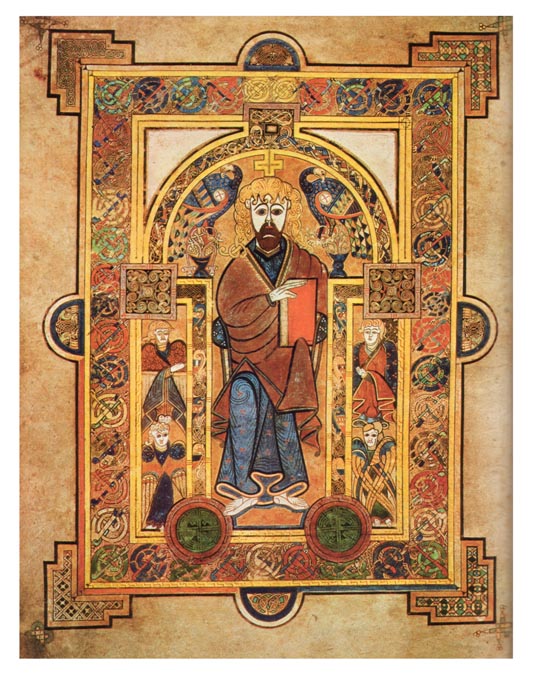
Imagine three Celtic artist monks, secluded in the scriptorium of Iona, or in eastern Scotland, or in a new monastery at Kells, County Meath, Ireland. They welcome in the year 800 A.D. in days filled with extraordinary artistry and commitment. The Book is written on prepared calfskin (vellum) and contains 340 folios. The pages were severely trimmed and their edges gilded in the course of rebinding in the 19th Century.

This treasure of medieval Europe is an illuminated manuscript Gospel book in Latin. It contains the four gospels of Matthew, Mark, Luke, and John, along with prefatory texts and tables.
In The Annals of Ulster it is described as “the chief treasure of the western world.” It records that it was stolen in 1006 for its ornamental cumdach (shrine). It remained at Kells throughout the Middle Ages, venerated as the great gospel book of St. Colum Cille c.561.
In 1090 the relics of Colum Cille were brought to Kells from Donegal. Following the rebellion of 1641, the church at Kells lay in ruins. In 1653 the book was sent to Dublin by the governor of Kells in the interest of safety. The Book of Kells has been on display in the Old Library at Trinity College in Dublin from the mid-19th Century. A half-million visitors a year visit the Library.
A range of pigments were used, including blue made from indigo or woad, native to northern Europe. Orpiment used produced a vibrant yellow pigment. Red came from red lead or from organic sources which are difficult now to identify. A copper green, reacting with damp, was responsible for perforating the vellum on a number of folios. The monks used a technique of adding as many as three pigments on top of a base layer. Their results are an outstanding art work and beautiful Book of Kells. The Book is a masterwork of Western calligraphy and represents the pinnacle of Insular illumination.
The Book of Kells unprecedentedly has elaborate orientation that covers the pages that includes 10 full-page illustrations and text pages that are vibrant with decorated initials and interlinear miniatures. The Insular majuscule script of the text appears that the lettering is in iron gall ink and the colors used were derived from a wide range of substances, some of which were imported from distant lands.
Kells Abbey was plundered and pillaged by Vikings many times in the 10th Century. It is unknown how the Book survived. Possibly the monks had buried it in the ground. In the 12th Century land charters pertaining to the Abbey of Kells were copied on to some of its blank pages. It was common practice to copy charters on to important books in the medieval period. The Abbey of Kells was dissolved due to the ecclesiastical reforms of the 12th Century. The abbey church was converted to a parish church in which the Book of Kells remained.
In 1654 Cromwell’s cavalry was quartered in the church at Kells and the governor of the town sent the book to Dublin for safekeeping. Except for brief loans to other libraries and museums, the Book of Kells has remained at Trinity College since 1661.
The astonishing beauty and fine craftsmanship is the very “shrine of art.” The intricacies, so delicate and so subtle, so full of knots and links show colours so fresh and vivid that you might say that all this was the work of an angel and not of a man.
The three laboring monks could not have known that 12 centuries of their work would be one of Ireland’s top tourist attractions. The magnificent masterpiece has been commissioned to publishers Thames & Hudson to compile a new edition in commercial book form of this priceless work. The new edition costs around $100.

